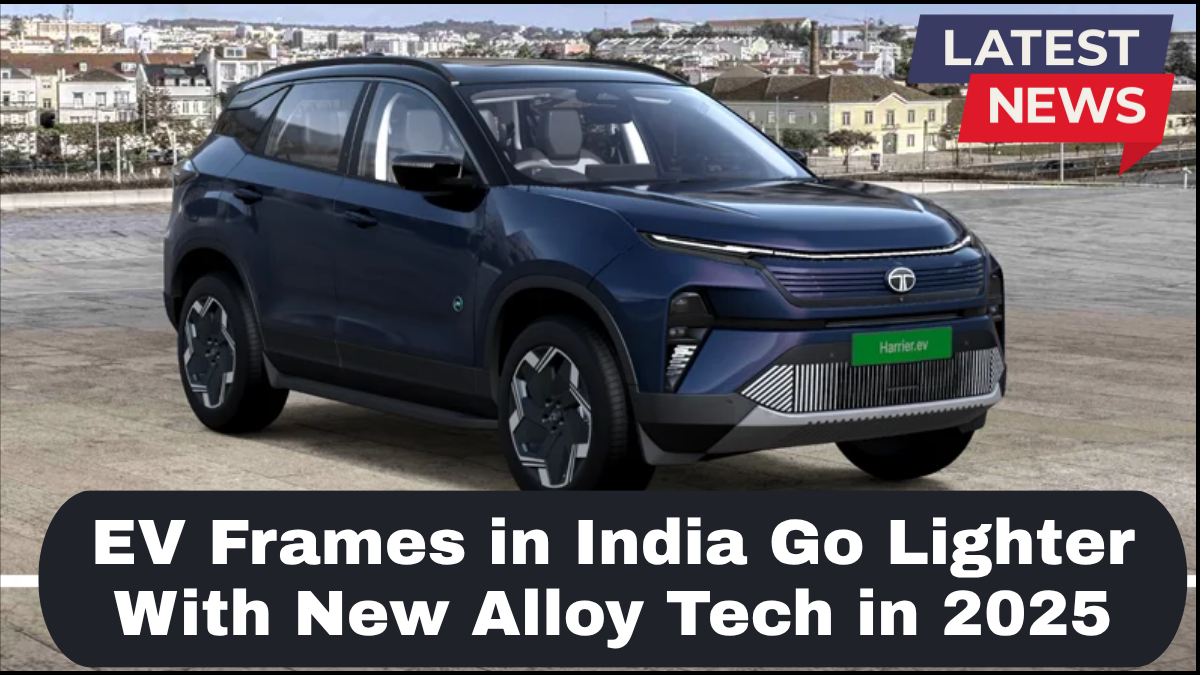India’s electric vehicle (EV) sector is entering a new phase of innovation in 2025, with lightweight alloy use in EV frames emerging as a key turning point. Automakers are shifting their material strategies to keep up with performance demands, sustainability goals, and global competition. The traditional reliance on heavy metals is being replaced by smart, efficient alloys that promise improved range, better safety, and enhanced structural strength — all while reducing the overall vehicle weight.

The Material Revolution Behind EVs
The shift from internal combustion engine (ICE) vehicles to EVs isn’t just about battery packs and electric motors. A more subtle but equally crucial evolution is happening beneath the surface — in the frames and chassis. In 2025, India is witnessing a clear auto material shift, moving away from conventional steel-heavy constructions towards high-performance lightweight alloys.
These modern alloys, primarily aluminum-magnesium blends and advanced high-strength steel (AHSS), are tailored to balance weight reduction with the durability required for Indian road conditions. Titanium and carbon-fiber composites are also being tested in premium segments and performance EVs.
Why Lightweight Alloy Use in EV Frames Matters
-
Enhanced Battery Efficiency and Range
Reducing the vehicle’s weight directly improves battery efficiency. A lighter frame means the motor needs less power to move the vehicle, translating to longer driving ranges — a critical factor for Indian consumers concerned with charging infrastructure. -
Improved Performance and Handling
Lightweight frames reduce the overall inertia, allowing for quicker acceleration and better maneuverability. This is particularly beneficial for urban mobility vehicles such as e-scooters, e-rickshaws, and compact EVs, where nimble handling is essential. -
Lower Manufacturing and Maintenance Costs
Contrary to popular belief, lightweight alloy use in EV frames can lower lifecycle costs. Alloys like aluminum and magnesium are not only recyclable but also easier to machine, reducing fabrication time. Additionally, their resistance to corrosion extends the lifespan of EV components.
India’s Auto Material Shift: What’s Driving It?
Several factors are pushing this transformation in India’s automotive landscape:
-
Regulatory Pressures: With stricter Corporate Average Fuel Economy (CAFE) norms and government pushes for reduced vehicular emissions, automakers are under pressure to build greener and more efficient vehicles.
-
Government Incentives: Under schemes like FAME II and the Production-Linked Incentive (PLI) scheme, manufacturers using advanced materials and localization are rewarded with subsidies and tax benefits.
-
Growing EV Market: As the Indian EV market expands — expected to grow over 40% CAGR through 2030 — companies are racing to differentiate their models with innovation in both tech and materials.
-
Global Collaboration: Joint ventures with international tech and material firms are introducing cutting-edge alloy formulations into Indian manufacturing lines. For instance, partnerships with Japanese and European companies are helping Indian OEMs access proprietary alloy blends for next-gen EVs.
Use Cases: Where Alloys Are Being Applied
In 2025, we’re seeing alloy applications in:
-
Scooter Frames: Brands like Ola Electric and Ather are incorporating aluminum frames for their urban EVs, offering a perfect mix of rigidity and weight reduction.
-
Car Chassis: Tata Motors and Mahindra are experimenting with AHSS and aluminum-magnesium combinations to build stronger yet lighter body structures.
-
Battery Casings and Mounts: Alloys are also replacing plastic and steel in battery enclosures to improve thermal management and reduce fire risk.
Challenges and the Road Ahead
Despite the momentum, the transition isn’t without hurdles. Alloy costs remain high, especially for rare-earth infused variants. Moreover, India’s manufacturing ecosystem still lacks large-scale forging and casting capacity for some of these advanced materials. But investments are being made — including new foundries and training programs to upskill workers for alloy fabrication.
As the demand for lightweight, high-performance EVs rises, material science is becoming a battleground for differentiation. In 2025, India’s auto material shift is no longer a trend — it’s a necessity for long-term competitiveness.
Frequently Asked Questions (FAQ)
Q1: What are the benefits of using lightweight alloys in EV frames?
A: Lightweight alloys improve vehicle range, handling, and energy efficiency. They also reduce wear on components and contribute to longer battery life.
Q2: Which alloys are most commonly used in EV frames in India?
A: Aluminum, magnesium, and AHSS (Advanced High-Strength Steel) are widely used. Some manufacturers are also exploring carbon fiber and titanium for premium segments.
Q3: Are lightweight alloys safe for Indian roads?
A: Yes. Alloys used in EV frames are engineered for high strength and crash safety. They undergo rigorous testing to handle varied Indian terrains and weather conditions.
Q4: Will alloy-based EVs be more expensive?
A: Initially, they may carry a slight premium. However, savings in fuel (electricity), maintenance, and potential tax benefits often offset the cost in the long run.
Q5: How does this shift affect local manufacturers?
A: Local manufacturers are adapting by investing in alloy processing capabilities and forming global partnerships to access advanced materials and know-how.
click here to learn more